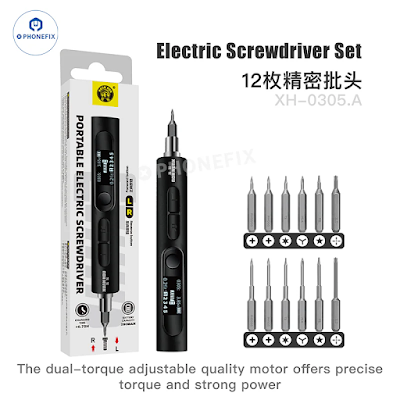How to Choose The Right Mobile Phone Repair Tools To Save Money?
In today's fast-paced world, mobile devices have become an integral part of our daily lives. Once they break down, the need for efficient and reliable repair services becomes particularly urgent. The choice of repair tools is not only about completing the repair task, it also directly affects your bottom line. Although investing in high-quality mobile phone repair tools may seem like a large initial investment, it is actually a strategic move that can bring considerable long-term savings.
1. Understand common repair needs:
Before choosing your tools, you first need to understand the most common types of phone repairs, such as screen replacements, battery replacements, and internal component failures (like the camera or charging port). For these common problems, you can assess which specific tools are needed. This will help you avoid buying unnecessary tools.
2. Choose quality over quantity (and don't go cheap):
Avoid underpriced tools: low-quality screwdrivers can break small screws, flimsy pry tools can scratch or break the phone's casing, and low-quality parts can quickly break down. These issues can lead to expensive parts replacements and extended repair times. Invest in durable, precision tools: High-quality tools ensure accuracy, ease of use, and faster repairs, which reduces the likelihood of errors and the need for repeat repairs. Look for tools made of sturdy materials like stainless steel.
3. Determine your repair needs:
Common repairs: For basic repairs like replacing a screen or battery, you'll need a core set of tools.
Advanced repairs: If you plan to tackle more complex problems, such as motherboard repairs or soldering, you'll need specialized equipment. Don't buy advanced tools until you're ready for these repairs.
4. Essential tools for beginners (affordable starter kit):
Precision screwdriver set: This is essential. Phones use micro screws with various head shapes (Phillips, Pentalobe, Torx, Tri-point). A good set prevents screws from stripping. Magnetic screwdrivers help secure micro screws.
Opening tools (pry bars and spudgers): Essential for safely separating phone cases and components without causing damage. Choose plastic tools instead of metal tools to avoid scratches.
Suction cups: Essential for lifting screens and back panels, especially on devices with adhesive.
Tweezers: Pointed anti-static tweezers are essential for handling small components and delicate cables.
Anti-static mats and wrist straps: Electrostatic discharge (ESD) can damage sensitive components of your phone. These tools discharge static electricity to protect your device and yourself.
Heat gun or hair dryer: Used to soften adhesive for screen or battery removal. Adjustable heat guns have more precise control.
Magnetic mats/trays: Help organize small screws and parts to prevent loss.
5. Consider tool kits:
Starter kits: Many retailers offer comprehensive repair kits that include basic tools. This is a cost-effective way to get started.
Brand-specific kits: For specific phone brands (such as iPhones), specialized kits may contain unique tools, such as Pentalobe screwdrivers.
Reduce damage: High-quality tools minimize the risk of damaging delicate internal components, which can prevent costly replacements.
Increase efficiency: Quality tools make repairs faster and easier, saving you time.
Durability: Durable tools last longer, reducing the need for frequent replacements.
7. Where to buy:
Reputable suppliers: Look for professional online retailers or local electronics stores that specialize in phone repair tools and parts.
Compare prices: Shop around, consider buying in bulk (if applicable), and look for discounts or specials.
8. Buy high-quality tools
While choosing lower-priced tools may save you money in the short term, it may increase your long-term costs by causing you to replace them more frequently due to poor quality tools. Investing in quality tools will not only improve your repair results, but also reduce the wear and tear of your tools.
9. Find the right supplier
Find the right tools through reputable online retailers or local electronics stores. You may also consider attending industry trade shows or conferences to directly contact manufacturers and obtain the appropriate tools and equipment to ensure that you get the best value for money.
10. Consider the used market
For some tools, you may want to consider looking in the used market or local repair shops. Many professionals sell tools they no longer need, which can be an economical way to obtain high-quality tools.
11. Learn repair skills
As well as choosing tools, learning some basic mobile phone repair skills can help you use them more effectively and avoid wasting too much money on unnecessary problems. In the process, the experience you gain will also enable you to complete repairs faster and more accurately, further reducing the tools or materials required for the next repair.
Conclusion:
Choosing the right mobile phone repair tools is a business strategy that combines cost-effectiveness and service quality. China PHONEFIX repair shop team is committed to providing a one-stop supply chain solution for mobile phone repair business, covering all categories of products such as mobile phone repair tool kits, parts and accessories, screen refurbishment equipment, and repair consumables. Help you maintain a competitive advantage in the rapidly iterating mobile phone repair industry, keep up with the trend of technological innovation, and provide customers with an excellent repair service experience.








.jpg)
Comments
Post a Comment